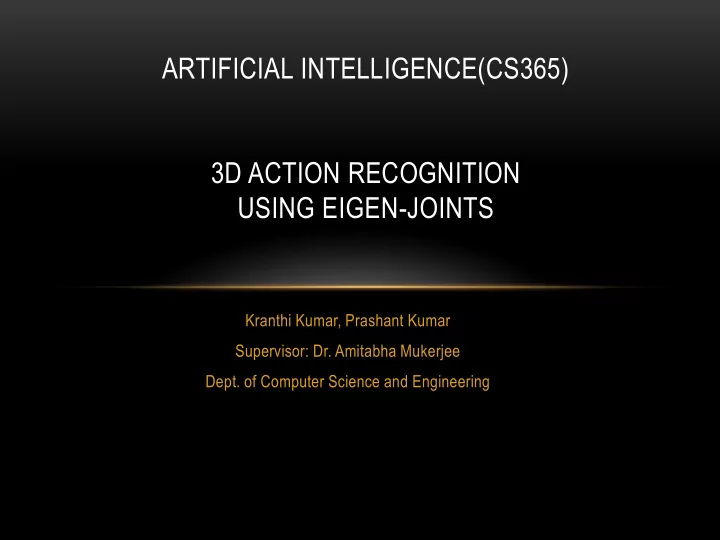

ARTIFICIAL INTELLIGENCE(CS365) 3D ACTION RECOGNITION USING EIGEN-JOINTS Kranthi Kumar, Prashant Kumar Supervisor: Dr. Amitabha Mukerjee Dept. of Computer Science and Engineering
PROBLEM STATEMENT • To recognize human actions using 3D skeleton joints recovered from 3D depth data. • 3D depth data is captured using RGB-D cameras such as Microsoft Kinect.
MOTIVATION • Human activity recognition is one of the important problem in computer vision. • It has uses in the fields of video surveillance, human- computer interaction, etc. • Health Care.
MOTIVATION • Content-Based video search • The video content is searched rather than metadata such as tag or keywords. • It is difficult to manually annotate images with metadata in large databases and it may incorporate incorrect information.
MOTIVATION • Xbox 360
MOTIVATION • Health Care
OVERVIEW • Eigen-Joints Representation • Naïve Bayes Nearest Neighbour Classification • Informative Frame Selection
DATASET • MSR Action3D • 20 action types performed by 10 different subjects. Each subject performing an action 2 or 3 times. • Provides sequence of depth maps as well as skeleton joints. • Recorded with a depth sensor similar to the Kinect device..
DATASET • UCF Kinect • Each frame has 15 joints. • 16 actions performed by 16 different subjects • Depth maps are not provided
EIGEN-JOINTS REPRESENTATION
EIGEN-JOINTS REPRESENTATION Static Posture Feature Consecutive Motion Feature Overall Dynamics Feature
EIGEN-JOINTS REPRESENTATION
NAÏVE BAYES NEAREST NEIGHBOUR(NBNN) • Non parametric classifier for action classification • No quantization of frame descriptors. Computation of Video-to-class distance, rather than conventional Video-to- • Video distance.
INFORMATIVE FRAME SELECTION • All actions can be viewed as combination of four phases:- • Neutral • Onset • Apex • Offset • Discriminative information between the frames is present mostly in the frames from onset and apex phases. • So, extract frames from onset and apex phases and discard frames from neutral and offset phases. Reduces computational cost as the number of frames is reduced. •
INFORMATIVE FRAME SELECTION • 3D depth of each frame i is projected onto 3 orthogonal planes, which generate 3 projected frames f v , v Є {1,2,3}.
REFERENCES • X. Yang, Y. Tian, Effective 3D action recognition using EigenJoints, 2013. O. Boiman, E. Shechtman, M. Irani, In Defense of Nearest-Neighbor Based • Image Classification, 2008.
Recommend
More recommend